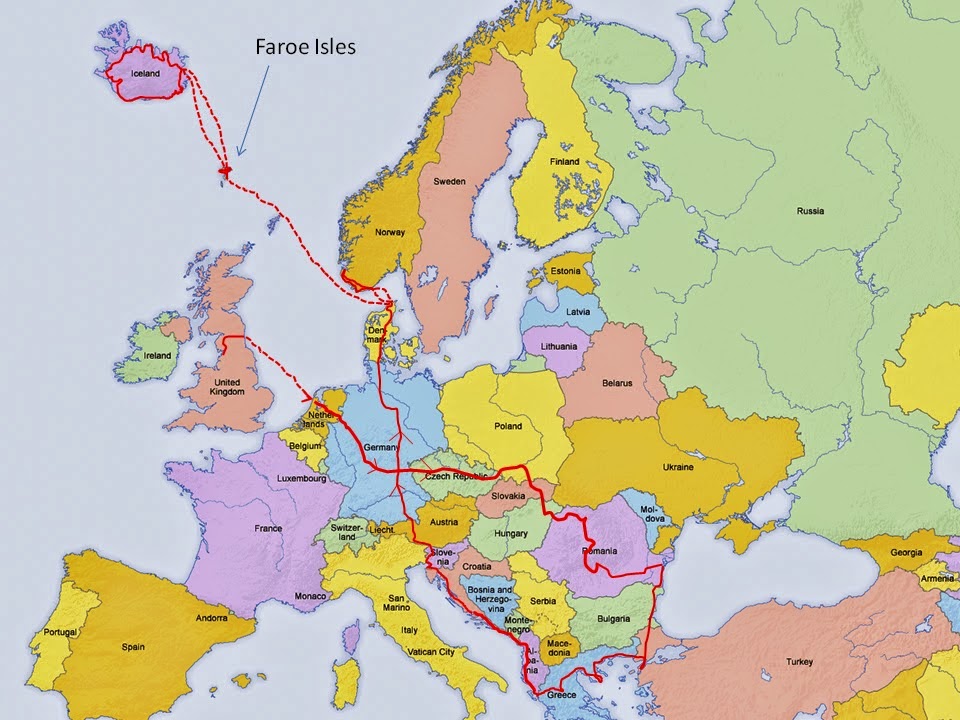Day 85 Faroe Isles
Before this trip I didn’t know much about the Faroes other
than a Specsavers TV ad filmed where the old sheep shearer shears his collie
instead of one of his sheep.....and fish.
The Faroes are made up of many islands (15 of which are
inhabited) just as our Orkneys and Shetland isles are and they are also of a
similar size. The climate is pretty much the same if not a little wetter, they have their own
language and they share their currency with Denmark. Their nearest neighbours
are Shetland but it is their remoteness and small size that really
characterises them as does their landscape.
 |
| The van at the head of the Fjord |
The mists cling to the high ground much of the time and it
is home to the highest sea cliff in the world – 750m vertically straight into
the ocean. But what is very much different from our own remote Scottish islands
is the massive investment they have put in to their infrastructure.
There is very little farm land, the islands are all steep
sided, stepped and soil coverage is thin. They struggled to find a large enough
flat area low enough to put an airport on and have settled for a site which
they have had to build out on at both ends to get a decent length of runway on.
However each fjord and inlet, of which there are many, has a harbour and each
harbour, without exception, has fishing
boats both big and small and it is their income from fish that keeps the
islands prosperous.
Over the last 40 years they have progressively interconnected
their islands with tunnels or causeways and connected up remote village after
remote village with tunnels. I just can’t imagine us ever building a 1.5 Km
tunnel though a mountain to connect up a hamlet of 15 houses and 40
inhabitants, nor building 4 tunnels of a total length of 7 Km to a village of
30 houses. They have aggressively tackled depopulation such that it is not an
issue; the bonus for us as visitors is that we get to really see all around the
islands and it is a real treat to enjoy.
 |
| The drunk sat in his boat |
After our 4;30 am bed it is a struggle to get everyone up.
The sun is up and I walk around the fjord to a small harbour where I am
surprised by a greeting from a fisherman who is sat in a boat. He speaks no
English and although it is only 08:00 a.m. he offers me a drink from his bottle
of wine - I politely decline and then we
have some sort of conversation about fishing and camping before I make my way back
to the van.
We spend the day making our way slowly north and east heading to Vidoy to find a place to stay. We stop for the best ‘coffee and cake’ in someone’s front room in Erdi, waffles and apple cake, jugs of coffee and tea, meringues and an invite into their own bathroom as the ‘cafe’ toilet.....it also had our 1st wifi for a while which went down well.
 |
| Coffee and cakes in someone's dining room |
Over the hill we stop off at Gjogv and walk down to the
sea. All Faroese villages and towns have some multi coloured wooden houses,
some of which have turf roofs and Gjogv is a perhaps one of their best
examples.
 |
| Gyogv - picture perfect |

 The seas are big – cliffs and massive waves are all around and Gjogv
is pretty typical of many of the small
places where the effort and risk out in to fishing is something to be admired.
Harbours constructed in the most difficult of places most of which with steep
winch ramps to get the boats in and out of the water.
The seas are big – cliffs and massive waves are all around and Gjogv
is pretty typical of many of the small
places where the effort and risk out in to fishing is something to be admired.
Harbours constructed in the most difficult of places most of which with steep
winch ramps to get the boats in and out of the water. We move on through a 7 Km undersea tunnel to the eastern
isles and at the most northerly tip of the whole island group, on a road to
nowhere, we find a top spot for the van. The view is the wild seas and it in all directions but south
We move on through a 7 Km undersea tunnel to the eastern
isles and at the most northerly tip of the whole island group, on a road to
nowhere, we find a top spot for the van. The view is the wild seas and it in all directions but south |
| Jack on the BBQ |
It is then that I read in my tourist info material that
camping outside of campsites is strictly forbidden on the Faroes....a minute
later a bloke mysteriously appears from nowhere, loiters for a while, rings
someone and then returns. We expect a full turn out of the locals, the neighbourhood
watch or the police but it all comes to nothing.
 |
Day 85 Kaldbakstobotnur (Fo) to Vidareidi ( Fo) 158 Km
Total 12294 Km



No comments:
Post a Comment